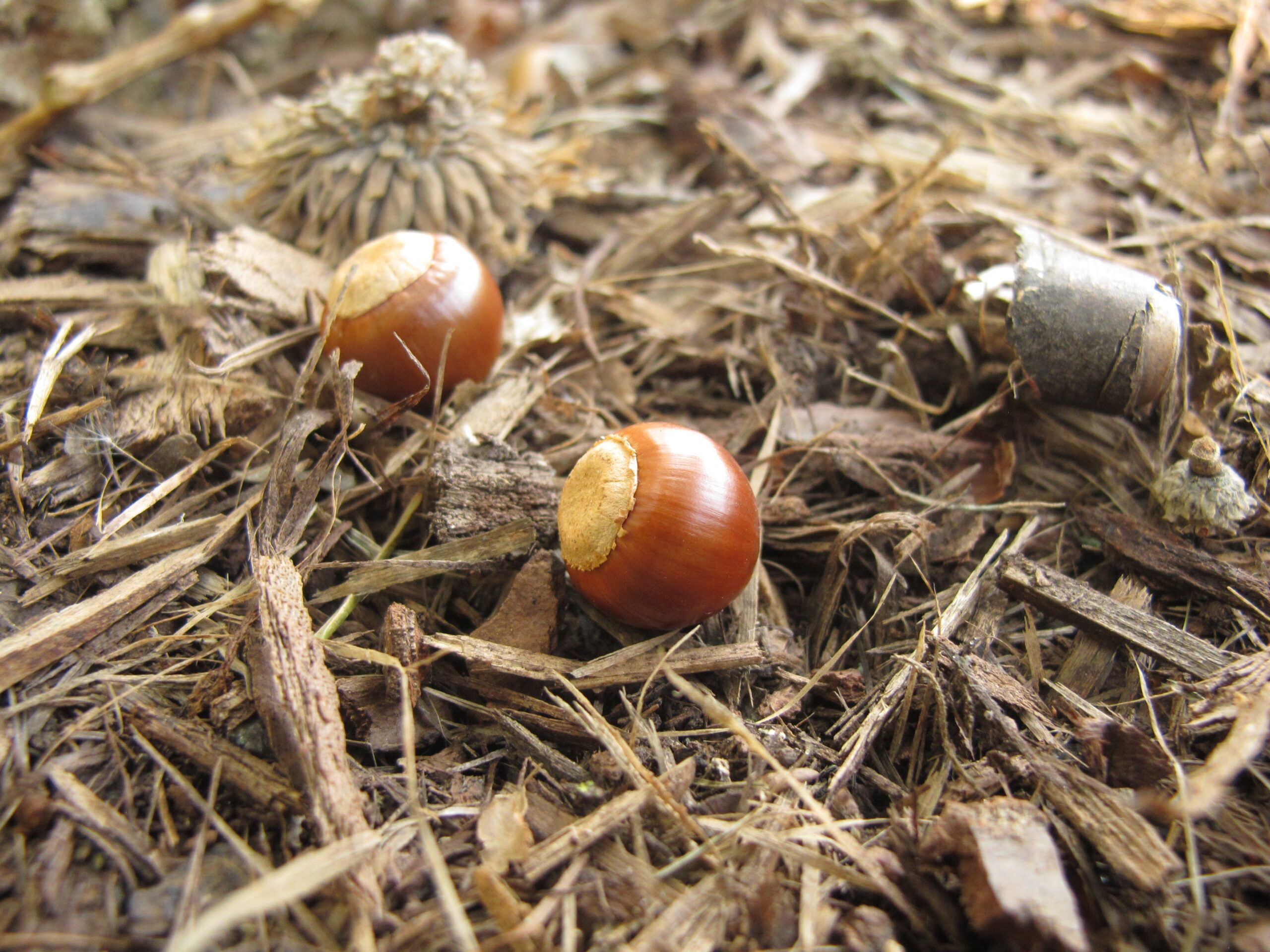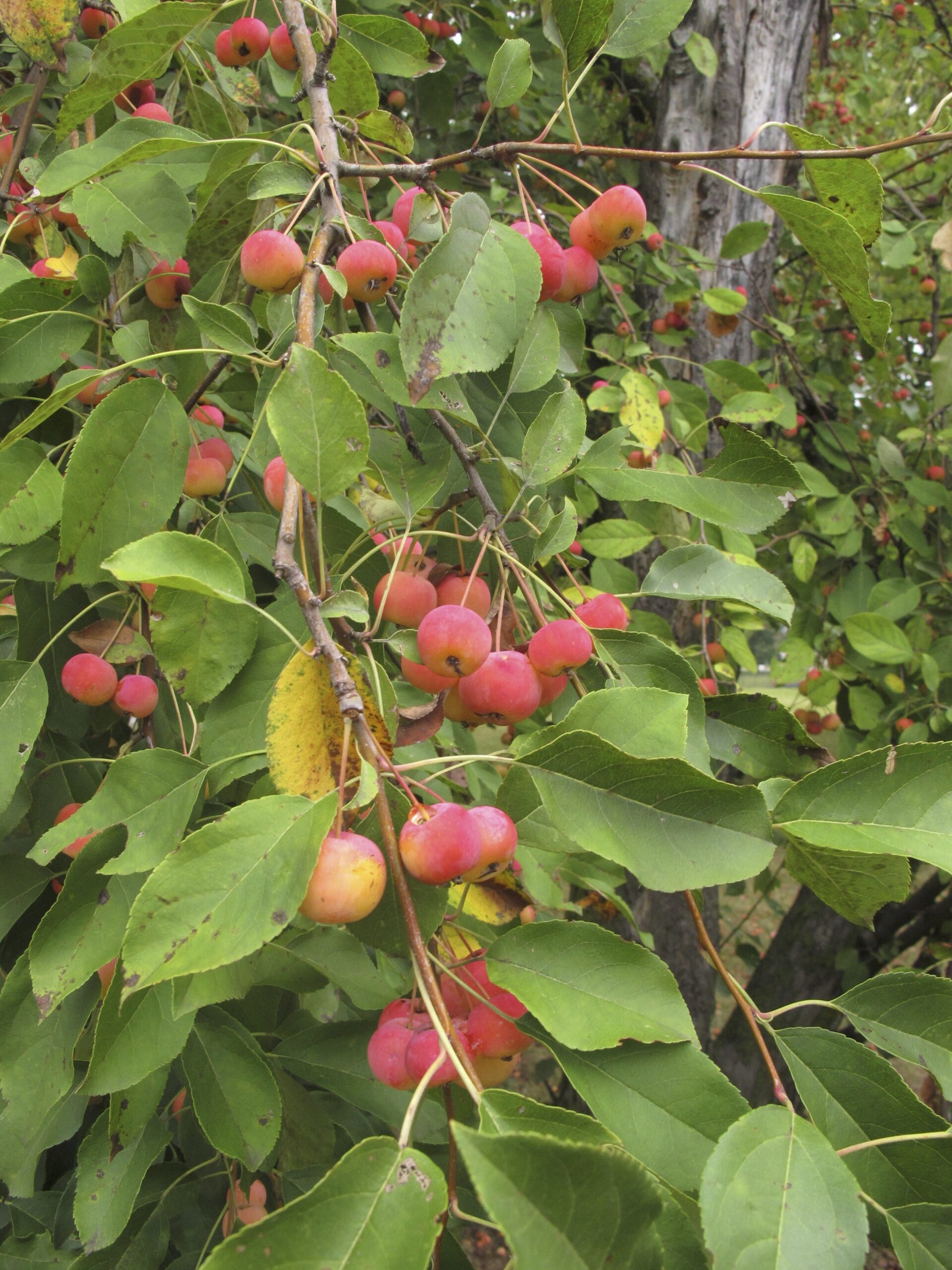
This story is a part of “A Year in the Wild Kitchen of the Great Lakes,” a series in partnership with expert forager Lisa M. Rose, with the mission of nurturing a deeper connection with the natural world through foraging. To get started with your foraging journey, begin here with our “Framework to Sustainable and Safe Practices.”
Autumn brings with it a bounty of fruits and nuts that often go unnoticed in our modern culinary landscape. Among the most abundant and overlooked are acorns and wild apples. These humble offerings, steeped in history and tradition, hold within them the flavors and nutrients that have sustained countless generations. Today, we revisit their culinary virtues, not just as ingredients but as symbols of a season rich with potential.
Acorns aren’t just for squirrels
Oak (Quercus species)
Edible parts: Edible nut

Acorns unshelled. (Photo Credit: Lisa M. Rose)
The acorn, often considered a nuisance as it scatters across lawns and driveways, is an overlooked nutritional powerhouse. Historically, acorns provided indigenous peoples with a versatile carbohydrate, unmatched by any other pre-European food source.
Packed with complex carbohydrates and plant proteins, acorns are a quintessential Michigan food, ripe for rediscovery. Once shelled and leached in water, acorn nutmeats take on a flavor similar to chestnuts, making them perfect for soups, nut butter or ground into flour for baking. With a bit of effort, these bitter nuts can be transformed into a delicious and versatile ingredient in the kitchen.
Acorns not only nourish our bodies but also foster relationships and a sense of community. Each fall, I process enough nuts to make 10-15 pounds of flour, which I use in various dishes, from acorn chai to acorn bread — a favorite among friends and family. My family and I gather them from our yard, and friends often drop off bags full of acorns. Shelling acorns has become a communal activity, whether during a Sunday football game or at a cocktail party.
Foraging the acorn
Ask any seasoned forager, and they’ll likely tell you that white oak acorns are preferred due to their lower tannin content. While this is true, red oaks can be equally delicious after winter leaching.
Squirrels have perfected this process, burying red oak acorns in the ground to leach out the tannins over the winter. By spring, these acorns are tasty enough for even the most discerning palate. Regardless of species, both types of acorns are edible once processed.
How to identify: White and red oaks (genus Quercus) are identifiable by their gray bark and alternate leaves, clustered at the terminal bud, each with soft, round edges. To discern between the two groups of oaks, white oaks have round-tipped leaves and red oaks have pointed leaves. Leaves can be deeply lobed or have no lobes at all.

Red oak acorn, being gathered from the ground. (Photo Credit: Lisa M. Rose)

Acorns begin to drop in August and continue to fall throughout the season. The first wave is often the tree’s cast-offs — small, underdeveloped nuts that are best ignored. The second and third waves bring the real harvest, and you’ll find yourself competing with squirrels to gather them.
Acorns can be gathered well into the winter, particularly the red acorns, which benefit from a winter’s leaching. As you collect acorns, discard any that show signs of insect infestation or have damaged caps. Look for firm, clean, and fresh-looking nuts.
The next step is shelling and leaching the nutmeats.
Shelling and Leaching Acorns: A labor of love

Red acorn being processed. (Photo Credit: Lisa M. Rose)
Shelling acorns can be done by hand with a hammer or pliers, but for larger batches, a hand-cranked nutcracker is a worthwhile investment. The goal is to keep the nutmeats as intact as possible for easier processing.
Leaching the acorns removes the bitter tannins, making the nutmeats palatable. This can be done using either a hot or cold water process. The hot water method is quicker, involving finely chopping the nutmeats and simmering them in water, changing the water repeatedly until the acorns taste nutty rather than bitter. Once leached, the nutmeats can be dried for long-term storage.
Preparing Acorns for Flour: From nut to bread

Three stages of acorn flour. (Photo Credit: Lisa M. Rose)
To make acorn flour, the dried nutmeats need to be ground into a fine powder. A coffee grinder works well for this task. The flour can be used immediately or stored in the freezer to extend its freshness. Processed acorn flour can also be frozen to prevent it from going rancid and to maintain its freshness.
Acorn Banana Bread Recipe

Finished acorn bread. (Photo Credit: Lisa M. Rose)
Yield: Makes one 9×5 inch loaf
Enjoy the nutty richness of foraged acorn flour in this moist, flavorful banana bread — perfect for a cozy autumn treat.
Ingredients:
- 1 cup all-purpose (or gluten-free) flour
- 1 cup processed acorn flour
- 1 tsp baking soda
- 1/4 tsp salt
- 1/2 cup butter
- 3/4 cup brown sugar
- 2 eggs, beaten
- 2 1/3 cups mashed overripe bananas
- 1-2 tbsp cocoa powder (optional)
Directions:
- Preheat oven to 350°F (175°C). Lightly grease a 9×5 inch loaf pan.
- In a large bowl, combine the flours, baking soda, and salt.
- In a separate bowl, cream together the butter and brown sugar. Stir in the eggs and mashed bananas until well blended. Add cocoa powder if desired.
- Pour the batter into the prepared loaf pan.
- Bake for 60 to 65 minutes, until a toothpick inserted into the center comes out clean. Let the bread cool in the pan for 10 minutes before turning out onto a wire rack.
Wild Apples: Nature’s Sweet Gift
Wild Apple (Malus species)
Edible Parts: Flowers, fruit, bark, leaves

An amalgam of wild apples. (Photo Credit: Lisa M. Rose)
While acorns require some effort to process, apples are ready to enjoy right off the tree. Whether you’re foraging in the wild or picking from a backyard tree, the crisp, juicy fruit of the apple tree is a fall staple that never disappoints. Wild apples, in particular, offer a unique, robust flavor that is perfect for a variety of culinary uses.
From pies and sauces to cider and vinegar, the possibilities are endless. The high pectin content in wild apples makes them ideal for preserves, while their natural sweetness and acidity lend themselves beautifully to both sweet and savory dishes.

Pressing wild apples for cider making. (Photo Credit: Lisa M. Rose)
If you are a cider enthusiast, wild apples yield a cider that is fresh, crisp and dry. The wild apple’s high tannin levels can make cider flavor profiles and aromatics in the final batch hard to predict. If your cider happens to go off, it can easily be finished off to make a fine homemade raw apple cider vinegar, which has many culinary and medicinal uses. The wild apples — along with wild sugars like raw honey — can create the most amazing and flavorful apple cider vinegar through the fermentation process.
And let’s not forget the medicinal benefits: apple tea made from blossoms and twigs can soothe digestive troubles, while apple cider vinegar is a time-honored remedy for a range of ailments.
How to Identify & Gather: The apple is a fruiting tree, with brown, scaly bark and dense branches. Its leaves are ovate with serrated margins and a light-colored underside. The flowers of the apple tree are arranged in corymbs, each flower having five petals that range in color from pinkish white to white, with multiple stamens.

Wild apple, ripe hanging over a hiking trail. (Photo Credit: Lisa M. Rose)
Apple trees are very common in parks, on public land, and along trails — particularly if the land was historically an orchard or farmstead. Apple trees are also common as ornamentals, and the smaller varieties are a purposeful addition to an urban landscape plan.
Being attuned to the apple’s harvest time will help you select a well-ripened apple that has a nice aroma for eating, baking, and cider-making. The apple blooms in late April to May, and the blossoms can be gathered and dried for tea or even prepared as flower essences.
Fruits become ripe in mid- to late fall. As an apple ripens, its aromatics become more pronounced. The skin of the apple contains aromatic oils, acids, tannins (bitter and astringent substances), yeasts, and pigments high in antioxidants. An unripe apple’s skin will be noticeably tannic.
Apples that detach easily from the tree and freshly fallen apples are most ripe. Choose apples that are free of insect damage as the fruit is frequently subject to resident caterpillars.
Allowing the apple to ripen closer to frost and wildcrafting fallen fruit will ensure the most ripened sugars and aromatics.
The Crabapple: Small but mighty
The crabapple, a wild variety of apple, is another fall foraging favorite. Though smaller and tarter than its cultivated cousins, the crabapple is equally versatile in the kitchen. Its tartness is perfect for making jellies, butters, and ciders, and its small size makes it a convenient trail snack for hikers.

Crabapples, the small but as mighty sibling to larger, wild malus species. (Photo Credit: Miriam Doan)
The crabapple can be swapped out by equal weight for recipes calling for apples. Apple butters, chutneys, applesauce, jelly, cider, crumbles, pies, and fruit leathers can all be prepared with the crabapple. Because the fruit is small, removing the seeds can sometimes be tedious. The fruit should first be run through a food mill for recipes like sauces and leathers to improve the texture of the final product. Crabapples can be pressed and fermented into raw apple cider vinegars as well as made into ciders.
How to Identify & Gather: Crabapple trees are widely distributed across the Great Lakes, in fields and hedgerows, and even urban landscapes. When foraging, look for fruit that is firm and free of insect damage. The best time to harvest is after the first frost, which sweetens the fruit and enhances its flavor.

Crabapple fruit heavy on the tree. (Photo Credit: Lisa M. Rose)
In the spring, crabapple trees are filled with clusters of pinkish white to deep rose-colored flowers that attract honeybees. Like the wild apple, the crabapple tree has brown, scaly bark with dense branches. Its leaves are ovate and scalloped, with a gray underside. The fruit begins to ripen in summer; a wet growing season will yield 1- to 2-inch fruit ranging from yellow to red.
Look for crabapples to grow in abundance on public land, near hiking trails, in orchards, and on farmsteads. The crabapple is also a common ornamental, and often the fruit is left unharvested. Of course, always ask permission before gathering on private property. The fruit is ready in late summer and well into the fall.
The growing season affects the crabapple’s flavor. A dry season will result in a drier, more mealy fruit. A wet season will result in a more juicy, succulent fruit.
As the fruit ripens, the crabapple becomes more sweet. Wait for the ripening crabapples to soften, and harvest them after the first frost as they will be noticeably more sweet. Choose fruit that has little insect damage or molds.
Crabapple Butter Recipe

Wild apples transformed into apple butter and jelly. (Photo Credit: Miriam Doan)
Yield: Makes 6 pints
A tart and spiced delight, this crabapple butter is slow-cooked to perfection, capturing the essence of fall in every spreadable bite.
Ingredients:
- 3 pounds crabapples, washed and halved
- 1 cup granulated sugar
- 1 cup light brown sugar
- 1 tbsp ground cinnamon
- 1/2 tsp freshly grated nutmeg
- 1/4 tsp ground cloves
- 1/4 tsp salt
- 1 tbsp pure vanilla extract
Directions:
- Combine the crabapples, sugars, cinnamon, nutmeg, cloves, and salt in a medium bowl.
- Transfer the mixture to a slow cooker and cook on low for about 10 hours, stirring occasionally.
- Once thickened, transfer the mixture to a food processor or food mill. Add vanilla and puree until smooth.
- Serve on breads, muffins, or as a glaze for meats.
About the Author

Lisa M. Rose is an ethnobotanist, wild foods chef, and author with a profound dedication to exploring the symbiotic relationship between humans and plants. With an academic background in anthropology and community health, her culinary journey has been rich and varied, including stints with notable establishments and figures such as Stags Leap in Napa Valley, Alice Waters’ The Edible Schoolyard, and organic farmers in Northern Michigan.
Rose’s work is celebrated in her bestselling books, “Midwest Foraging” and “Midwest Medicinal Plants,” among others and her expertise is frequently sought by major media outlets, including the Chicago Tribune, PBS, NPR, Martha Stewart and CNN.
Catch more news at Great Lakes Now:
Foraged Flavors of the Sun: High Summer Wild Herbs and Plants
Wild Berry Bonanza: Juicy Jewels of the Great Lakes Summer
Featured image: Lisa M. Rose with using her father’s nutcracker to process acorns. (Photo courtesy of Lisa M. Rose)




